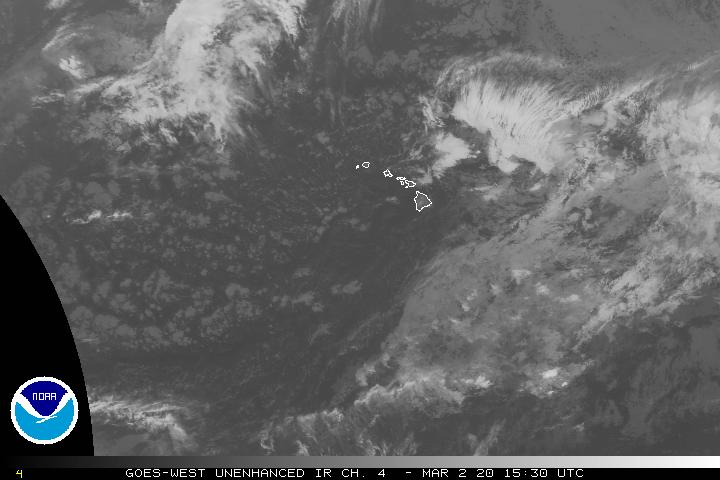Air Temperatures – The following high temperatures (F) were recorded across the state of Hawaii Saturday…along with the low temperatures Saturday:
76 – 71 Lihue, Kauai
82 – 72 Honolulu, Oahu
81 – 67 Molokai AP
85 – 65 Kahului AP, Maui
84 – 74 Kailua Kona
83 – 67 Hilo AP, Hawaii
Here are the latest 24-hour precipitation totals (inches) for each of the islands Saturday evening:
1.28 Mana, Kauai
4.24 PTWC, Oahu
0.00 Molokai
0.16 Lanai
0.00 Kahoolawe
0.49 Wailuku, Maui
0.98 Saddle Quarry, Big Island
The following numbers represent the strongest wind gusts (mph) Saturday evening:
18 Mana Ridge, Kauai
23 Kii, Oahu
20 Molokai
13 Lanai
15 Kahoolawe
15 Hana, Maui
21 Kaupulehu, Big Island
Hawaii’s Mountains – Here’s a link to the live webcam on the summit of our tallest mountain Mauna Kea (nearly 13,800 feet high) on the Big Island of Hawaii. Here’s the webcam for the Haleakala Crater on Maui. These webcams are available during the daylight hours here in the islands, and at night whenever there’s a big moon shining down. Also, at night you will be able to see the stars — and the sunrise and sunset too — depending upon weather conditions.
Aloha Paragraphs

Cold front just northwest…high pressure ridge over the islands

Cold front will stall near Kauai

Partly to mostly cloudy over the islands

Showers locally…some are quite heavy
Looping image
~~~ Hawaii Weather Narrative ~~~
Broad Brush Overview: Wet weather conditions across the western half of the state will prevail over the next few days. There’s the chance of embedded local heavy showers and isolated thunderstorms at times. South to southwest kona winds will blow through the first half of next week, as a low pressure system moves along the stalled frontal boundary just northwest of the state. As we push into Thursday, the stalled cold front will finally sweep down the island chain…spreading showers across the state through Friday.
Details: The current showers are developing ahead of the frontal boundary, and will move across Kauai first. The Garden Isle will find locally heavy showers, with the potential for isolated thunderstorms…spreading over Oahu. The rest of the island chain will see fewer showers, more of the scattered variety. Light southeast flow will also favor enhanced showers along the eastern and southeastern slopes of the Big Island. Thick volcanic haze (vog) is enveloping many of the smaller islands.
Looking Ahead: This nearly stationary frontal boundary will linger just northwest of the islands. A second low pressure system will move across the Central Pacific Monday and Tuesday, causing a low pressure system to develop just west of the islands. The wind directions will then veer towards the south and southwest kona direction in response to this developing low. The low center will track northeastward brushing past Kauai Tuesday evening, increasing shower activity across the islands through Wednesday as it passes.
This unusual and complicated weather pattern brings some uncertainty as to the onset timing of rain showers for each island. However it looks like Kauai and Oahu will likely see the most active showers, with heavy rainfall and a potential threat for flash flooding Tuesday into Wednesday…as the low pressure system passes through the area. A flash flood watch or even a warning may be needed for this time frame.
Colder air moving into the Central Pacific from the northwest will help to push this stalled front through the islands during the second half of the week. Extensive clouds and numerous showers are expected for areas within the frontal band. The latest model projections show the cold front passing through Kauai early Thursday morning, reaching Oahu by late morning, passing through Maui County Thursday afternoon into the evening…and stalling once again near the Big Island Friday.
Meanwhile a high pressure center moves eastward across the Central Pacific bringing a brief period of drier and more stable air to Kauai and Oahu. Model guidance continues to suggest that the shifting pattern may drive the stalled front back towards the central and northern islands next weekend. All of the above is rather complex, and fits in nicely with the unusual rainy season that we’ve been experiencing this year. It would be wise to stay tuned to the developments of this inclement pattern…as things will change along the way as usual.
Here’s a wind profile of the Pacific Ocean – Closer view of the islands / Here’s the vog forecast animation / Here’s the latest weather map
Marine environment details: A west-northwest swell that has arrived at levels slightly higher than predicted. A gradual downward trend is expected tonight through Monday.
Local winds are forecast to remain in the light to moderate range out of the southeast, which will continue to give way to overnight land breezes and daytime sea breezes this weekend near the coasts. The best chance for heavy showers and a few thunderstorms will remain over the northwest waters due to a front positioned west of the state. Winds are forecast to shift to the south-southwest Tuesday through mid-week, and increase into the strong category.

Full blue moon…second full moon of March
World-wide Tropical Cyclone activity
Here’s the Saturday Pacific Disaster Center (PDC) Weather Wall Presentation covering Tropical Cyclone 03W (Jelawat), and Tropical Cyclone 18P (Josie)..along with a tropical disturbance spread across the warm tropical waters of the Pacific
![]()
>>> Atlantic Ocean:
>>> Caribbean Sea:
>>> Gulf of Mexico:
Here’s a satellite image of the Caribbean Sea…and the Gulf of Mexico
Here’s the link to the National Hurricane Center (NHC)
>>> Eastern Pacific:
Here’s a wide satellite image that covers the entire area between Mexico, out through the central Pacific…to the International Dateline.
Here’s the link to the National Hurricane Center (NHC)
>>> Central Pacific:
Here’s a link to the Central Pacific Hurricane Center (CPHC)
>>> Northwest Pacific Ocean:
Tropical Cyclone 03W (Jelawat)
JTWC textual forecast warning
JTWC graphical track map
NOAA satellite image
Tropical Cyclone 18P (Josie)
JTWC textual forecast warning
JTWC graphical track map
NOAA satellite image
>>> North and South Indian Oceans / Arabian Sea: No active tropical cyclones
Here’s a link to the Joint Typhoon Warning Center (JTWC)
Interesting: The Sahara Desert Is Growing. Here’s What That Means – The Sahara — the world’s biggest hot desert — is getting even bigger. In fact, it is currently about 10 percent larger than it was nearly a century ago, and scientists suggest that climate change is partly responsible.
In a new study, researchers examined rainfall data gathered across Africa, consulting records dating back to 1920 and noting how changing conditions affected regions around the boundaries of the great desert.
They discovered that while some natural climate cycles could partly explain reduced rainfall and desert expansion southward, human-driven climate change is also playing a part. And if climate change continues unchecked, the Sahara’s slow growth will likely continue, the study authors reported.
Previously, scientists had explored the Sahara’s expansion by examining satellite data dating back to the 1980s. This study, which was supported by the U.S. National Science Foundation, is the first to analyze long-term trends in rainfall and surface air temperature over a timescale of nearly an entire century, the study’s lead author, Natalie Thomas, a doctoral candidate in atmospheric and oceanic science at the University of Maryland.
Deserts are defined as places on Earth that receive less than 10 inches of rainfall per year, according to the U.S. Geological Survey (USGS). With a surface area of about 3.6 million square miles, the Sahara is the third-largest desert in the world. Only the cold deserts are bigger: icy Antarctica’s frozen desert spans about 5.5 million square miles, and the Arctic desert covers around 5.4 million square miles, USGS reported.
“A strong expansion”
The study authors originally set out to examine seasonal cycles of temperature and rainfall across Africa, consulting data spanning 1920 to 2013. But their attention was quickly drawn to trends of decreasing precipitation in the Sahel, a semiarid region linking the Sahara to the savannas of Sudan. By looking at this more closely, they hoped to discover how rainfall trends might be linked to the Sahara’s growth over time, according to Thomas.
To a certain extent, many deserts’ boundaries expand and contract seasonally, as conditions fluctuate between wetter or drier. But the researchers found that there has been “a strong expansion” of the Sahara within the 20th century, Thomas said.
Depending on the season, the Sahara experienced growth of at least 11 percent, and it grew by as much as 18 percent during the driest summer months, according to data collected over roughly 100 years. Over the course of a century, it steadily expanded to become about 10 percent bigger than it was in 1920, the study authors reported.
Much of the Sahara’s overall size increase can be explained by climate cycles driven by anomalies in sea-surface temperatures. These cyclical changes in turn affect surface temperatures and precipitation on land, and their impact can last for decades, according to the study.
Decades of drought
One such cycle, the Atlantic Multidecadal Oscillation (AMO), entered what is known as a “negative phase” — with cooler-than-average sea-surface temperatures — in the 1950s, bringing heat and dry conditions to the Sahel region and fueling a drought that lasted until the 1980s, Thomas said.
Using statistical methods, the scientists compensated for the effects of the AMO on average rainfall, and thereby calculated how much of the Sahara’s growth could be explained by the dryness that the cycle’s negative phase produces. They estimated that the AMO accounted for about two-thirds of the desert’s expansion — but one-third of the Sahara’s remaining growth was likely the result of climate change.
The researchers’ findings point to changes that occur over decades rather than in a single year, and that makes it hard to predict exactly how the Sahara’s continued growth could affect the wildlife and people near its changing borders. But as the places where humans grow food become increasingly drier, some areas could become more vulnerable to drought, bringing a greater risk of famine to the people who live there, Thomas said.
The findings were published online March 29 in the Journal of Climate.












 Email Glenn James:
Email Glenn James:
TRACEY MCCULLOUGH Says:
Aloha Glenn: From Yin Denver home to Yang Poipu home. Still severe drought in Denver although the precipitation pattern is beginning to change. At Poipu home for only 10 days. Flew in and saw a magnificent sunset reflected off of Ha’upu ridge. As you have forecast, the rains are now camped over Poipu. No wind. Moderate to heavy steady rain. I think we may do an Easter Slug hunt later. I feel bad for folks staying for only one week on vacation. Doesn’t Look like we will see any sun for at least a week. Hope u are well. Thanks for keeping us abreast of the weather and such important events impacting our planet.
TRACEY
Poipu/Denver
~~~ Hi Tracy, nice to hear from you again! What ah life, Poipu and Denver, great choices in my book.
Indeed, Kauai will take the brunt of this current wet weather period, as will Oahu. Steady rain there hah, funny words about slug collections…rather than blue and yellow Easter eggs!
I doubt whether you will be cloudy for a week straight, I would imagine you might have a few rays sneaking through once in a while.
Thanks for checking back in, enjoy your 10 day visit to the Garden Ise!
Aloha, Glenn
Mike Says:
Glenn;
Just 3 more days until our annual sojourn to Maui. More than one month of bright warm days to enjoy. Will continue to watch your website for the diminishing vog over the next week. Hopefully it dissipates with easterly or north-easterly flow next weekend.
Mike
~~~ Hi Mike, good to hear that you’ll be here soon. I’m sure you’ll enjoy your month of fun here in paradise, and this vog won’t last too long…no one likes it!
Have fun!
Aloha, Glenn